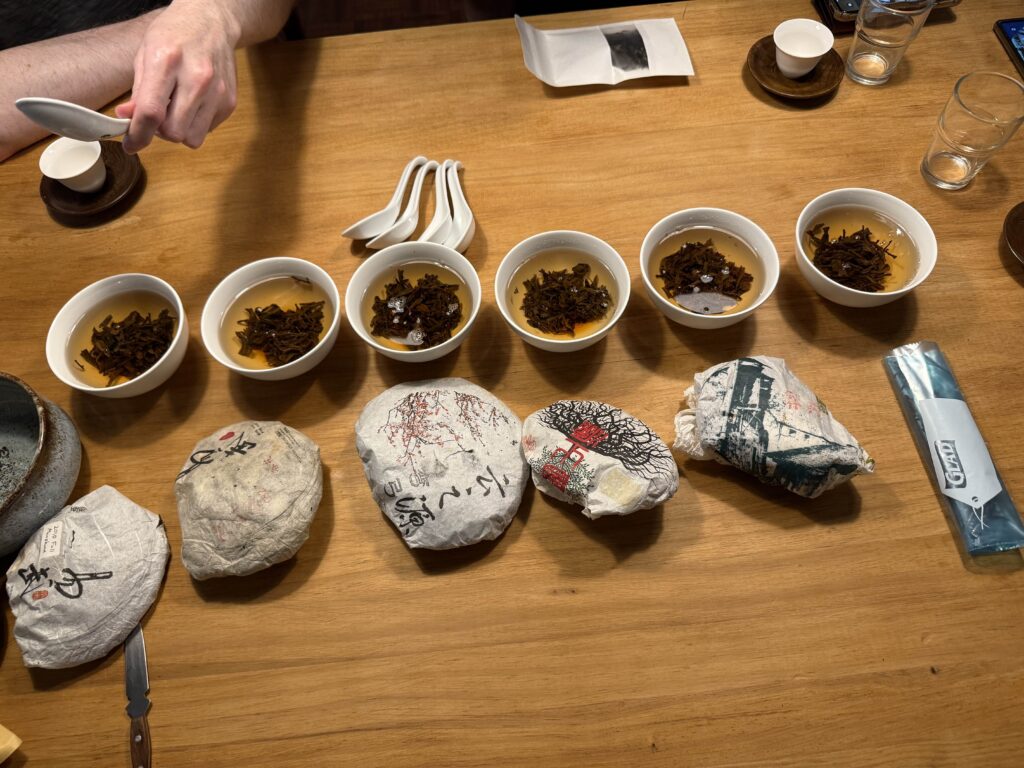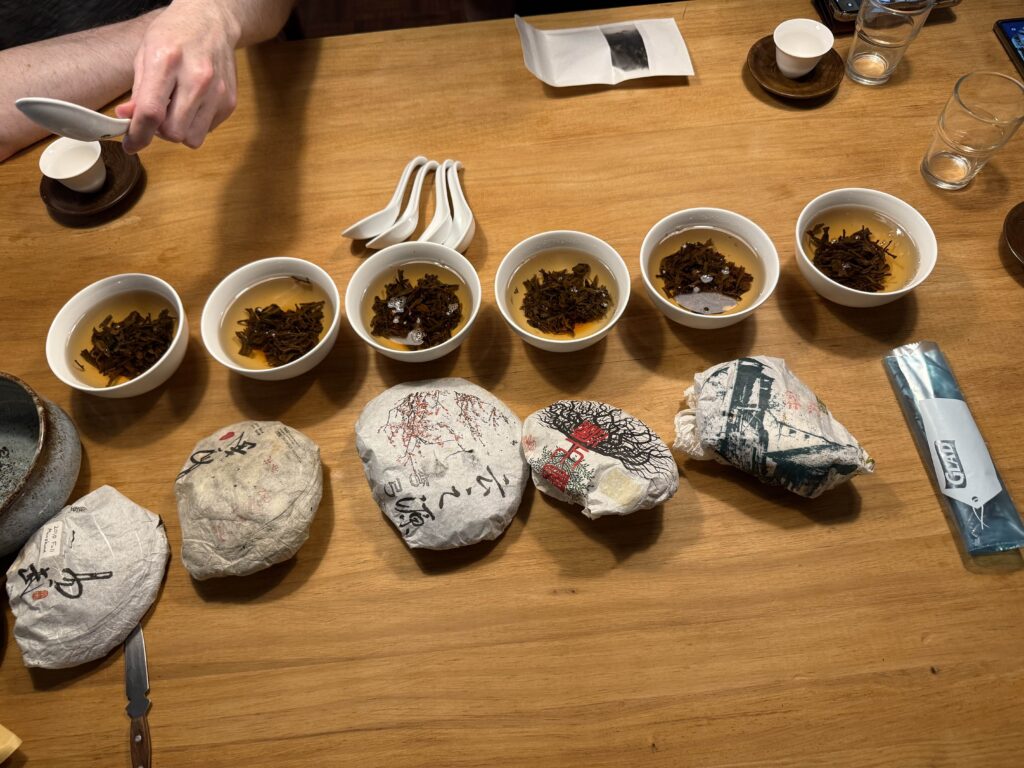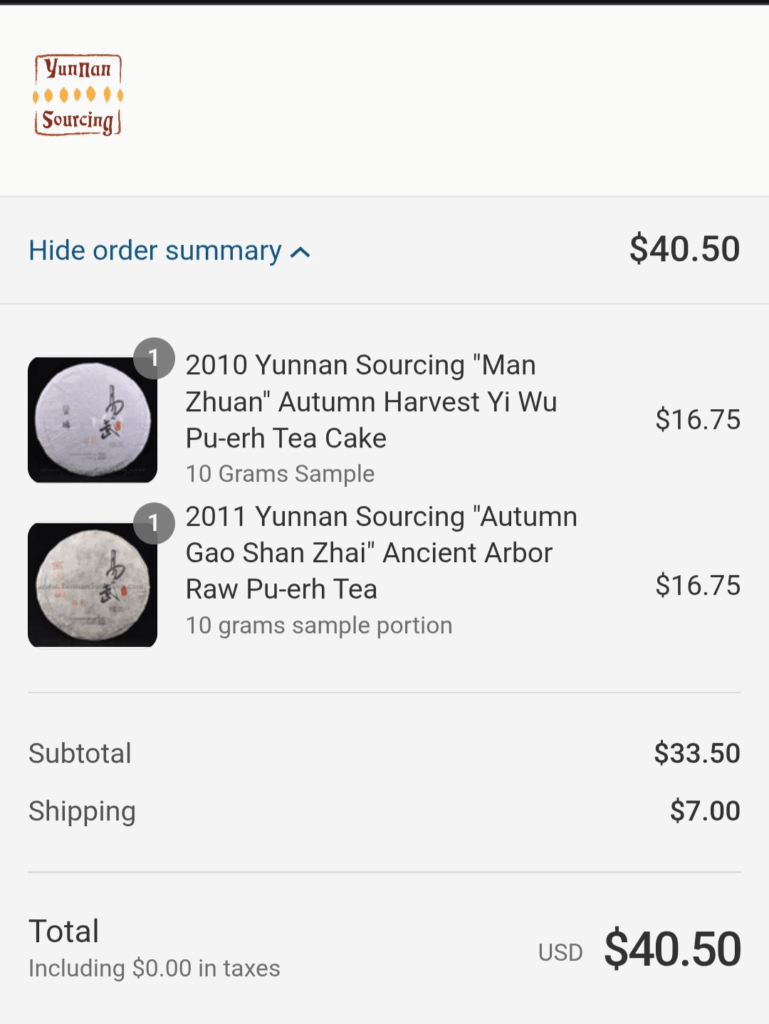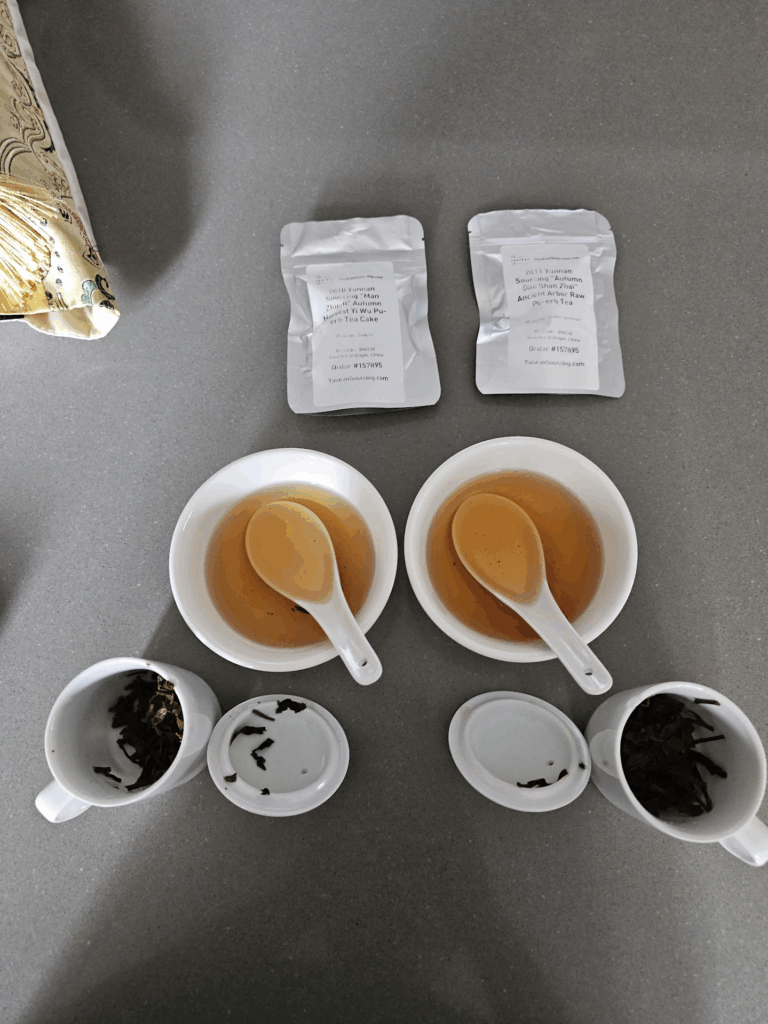Just about a dozen years ago I wrote a post about the dangers of green tea puerh. In short, young puerh that has been processed at too high a temperature that drinks well immediately but will age poorly. The same way if you drink old longjing it’s just…. bitter and gross. Well, a few weeks ago at a tea session with Alex of Taiwan Tea Odyssey we drank a tea that he has held for almost 14 years. It was a Yunnan Sourcing fall 2011 Yiwu Gaoshanzhai. The tea looked pretty ok – nice looking leaves, turning a bit yellow, but smells faintly of that old honeyed slightly aged puerh scent when dry. We brewed it gongfu. The first couple steeps seem ok – the tea has been aged in Los Angeles most of its life, only moving to Taiwan last year. We ascribed the issues with the tea – a bit of rough texture, weird flat notes and a bit of bitterness – to the LA storage. Then, we brewed it some more, and the nicer aspects of the tea – a cooling sensation, and some aged notes, started falling off, and the only thing remaining are stale green tea notes and a long lasting bitterness that doesn’t turn into sweetness.
Ok, here I thought we have a tea that is probably a mixture of green tea pu with some properly processed materials. The properly processed stuff was what made it taste ok in the initial steeps, but it gets overpowered by the bitter notes of aged green tea pu in the mixture. But, to be fair to the tea, we tried it again, this time in a lineup of bowl brews.


The lineup here is (left to right) 2010 Yunnan Sourcing Fall Manzhuan, 2011 YS Fall Gaoshanzhai, 2012 YS Fall Wangong, 2013 YS Spring Xiangming, a 2009 Spring Dianyi Mahei, and a 2012 Tea Urchin (RIP) Manzhuan. We used the same amount of tea and brewed with the same amount of water and just let it sit, which is a good way to evaluate a bunch of teas quickly while being able to compare them side to side. Try it sometime.
The first five teas all came from Alex’s storage, and were acquired around 2012/2013. The Tea Urchin tea was stored in Singapore almost this entire time. Of these teas, unfortunately our early friend the Gaoshanzhai was probably the worst of the bunch – the bitterness is the most obvious here, plus the poor mouthfeel. The other two fall teas also didn’t fare very well, but are a bit more faded but less bitter, to the point where they’re a bit bland at this point. The spring Xiangming was, I believe, cheaper when bought, and it showed. The Dianyi Mahei is ok, but not great for something that is now 16 years old. Finally, the Tea Urchin tea. It’s the best of the bunch – no weird bitterness that lingers, for one. It’s aging all right. But nobody can buy it anymore since the store is dead, so that’s that.
Now, dear reader, you might be thinking – Los Angeles is a horrible place to store tea! It’s not a surprise the Singapore stored tea is the best! Yes, I know. It’s dry, hot, and just not very good for aging puerh. Those of you who live there, go buy oolongs.
But I digress. To make sure that it isn’t Alex’s bad storage talking, I decided to do a public service and spend forty American bucks to buy two samples fresh from Yunnan Sourcing to make sure it’s not the City of Angels that’s causing problems for the teas.

After their arrival, I tried them.

Unfortunately I must report that Kunming or whatever storage Scott has for his teas are no better. I mean, we always know that Kunming storage isn’t the best, but in order to eliminate the possibility of Alex’s storage doing bad things to the tea, I had to find another source for it to make sure that’s the case, and there’s no better way to do it than to buy it from the source. After all, you can still buy whole cakes of these things from Yunnan Sourcing. I used 3g for 5 minutes brews. The Manzhuan, it turns out, is just very, very bland. It’s a bit rough, a bit bitter, but mostly just rather bland and hollow. The Gaoshanzhai is clearly made of better material – throat cooling, a bit of body, it has signs of good base material, but it also has the same problems as Alex’s sample – rough, very bitter, not much fragrance.
For an almost 15 years old tea, this is not good. It’s not going to get better at this point. It is quite clearly at least contaminated by at least some measure of green tea processed puerh in here. If you have cakes of this, I would be curious to hear your reports of how they taste now. I myself am wondering if a few cakes I bought from them around then are doing similar things – I haven’t tried them since I bought them. But if it’s at all similar to how these batches are turning out, things are not promising.
There were some questions in the dozen year old post about how to notice these issues – green tea processing most often shows up as teas that have a sort of green bean fragrance. It’s sweet and soft, with a beany taste. That bean taste is a product of a higher temperature shaqing that turns the tea into green tea – which also stops any prospect of future aging. If you’ve had stale green teas that are a few years old, you’d know how that tastes. It’s dry, rough, grassy in a bad way, and bitter. I haven’t bought that much new teas in the past ten years, so I have little idea how prevalent this issue still is at this point. However, if your puerh is getting more bitter over time, it’s a bad direction to go in.

 RSS - Posts
RSS - Posts
15 responses so far ↓
Scott Wilson // June 30, 2025 at 11:53 am |
All of my brand teas you mentioned here were sourced, processed, and pressed by Zhen Si Long. As far as the storage is concerned, you’ve made your bias very clear over the years, so no surprises there. BTW, you could have shown a modicum of politeness by replying to the friendly email I sent you when you made the order for these samples.
MarshalN // June 30, 2025 at 12:07 pm |
I have no idea who presses your teas – you don’t mention them by name, after all. The speculation has always been that they’re Hailanghaos, but I guess now we know.
This isn’t a storage issue – the problem is the processing. I’m sure you’d disagree, but I have had many Kunming stored teas that, while not aging very fast, do not turn like this. Regardless, I cannot recommend anyone buying this tea at this point given the price. I also made it clear I have not had a lot of newer teas of yours (or anyone else’s for that matter) to form an opinion on how they are these days. Perhaps this problem has gone away, that’s for someone else to explore.
Apologies for not responding to your email – that email address is now 100% just for getting things like order updates and the like. I’m sure we all have a few email addresses like that and is therefore also full of spam and adverts and random updates from businesses. So it’s not something I check for messages for me unless there’s a specific reason to do so.
Scott Wilson // July 1, 2025 at 7:30 pm |
I don’t know why you would need to speculate in regards to where the teas were pressed unless you were somehow unable to read the Chinese characters. The cakes in the wrappers are featured in a picture in this article, so you could have easily known that if you looked at the backside of the wrappers. Your assertion that you needed to speculate about their origin is very strange.
I feel confident that Zheng Si Long knows what they are doing and while you might not like this tea, it would be unfortunate if people developed the impression that well-respected brands such Zheng Si Long, Hai Lang Hao, and Yunnan Sourcing are churning out green tea pu to satisfy some sort market demand that doesn’t actually exist. I would say most 15 year old teas that were bitter young, will still be bitter with 15 years of Kunming storage. Have you tasted a 15 year Kunming aged 7542? It’s still going to deliver a lot of astringency and bitterness.
MarshalN // July 2, 2025 at 3:42 am |
Scott,
Not sure why you’re continuing to harp on who actually processed the tea. After all, we all know you no longer live in Kunming and haven’t done so for some time. Nobody knows your level of involvement in making these teas, so thanks for clarifying that you’ve basically outsourced the entire process to ZSL. The name on the back is merely where people press their teas – I have friends who go to Yunnan and press their cakes and the name of the factory that presses it appears on the back as standard regulatory requirement. It doesn’t mean that the factory sourced, processed, and determined the content of the cakes. My friends are responsible for that. Given that Yunnan Sourcing’s name is front and center, one would expect the same here but you seem to be suggesting that shouldn’t be the case.
Also, if you believe that I, after 25+ years of drinking pu, still cannot tell the difference between good and bad bitterness, then you should just ignore what I say. I should also point out that the issue with the Manzhuan 2010 discussed here is not so much the bitterness but rather than lack of much of anything going on – it’s a dying tea. Kunming storage, if anything, should preserve it. I’ve bought some Kunming cakes from 2015 recently that I actually felt are better than the same one stored in Taiwan for ten years. Storage condition is more than just speed. Given how the two times I tried these two teas they came from vastly different storage histories, I am pretty confident that this is not a result of bad storage.
Also, I have had some of your YS branded 2011 spring production of the Gaoshanzhai (I even bought five cakes if I remember correctly) and would not have done so if there’s already such a long lasting bitterness that would not turn into huigan. While the fall and spring productions are not the exact same tea, I doubt it is so fundamentally different in profile. Puerh aged for 14 years should not become more bitter as they age as a general rule.
Scott Wilson // June 30, 2025 at 12:25 pm |
Zheng Si Long 郑四隆茶庄 is printed on all the wrappers. 95%+ of the the Yi Wu raw we pressed to this day were sourced and pressed by them.
Grumpy Tea Guy // July 1, 2025 at 1:11 am |
Scott,
You’ve left me, and I imagine many others, confused by your reply. So in fact Yunnan Sourcing is not in fact actually Sourcing anything. Rather you’re just rewrapping cakes sourced and pressed by someone else. I gather that you now live in the US full time so has the entire operation been outsourced? It seems that this has been the case since at least 2011
What % of your puer are you physically involved in producing? You really do owe your customers an explanation.
Grumpy // July 3, 2025 at 6:51 am |
Scott,
I’m super curious….the 2015 Wa Long from ZSL is priced at $232. The Yunnan Sourcing 2015 Wa Long is priced at $536.
Are they the same tea? It certainly looks like it from the photos.
Mr. Hoffmann. // June 30, 2025 at 6:55 pm |
We’ve known for years that some companies like W2T, Crimson and YS present this issues, but it’s like no one dares to speak about it.
I applaud your honesty and to bring forward an issue that will result (and has!) in the mis-education and spread of false perception on what true puerh should be.
“You exchanged tomorrow’s aromas for today’s and that investment is now in bankruptcy.” Read from a respected tea seller and educator.
MarshalN // June 30, 2025 at 8:23 pm |
Common issue in China too not just western vendors. I first picked it up among cakes made by people here
TC // July 1, 2025 at 3:56 pm |
Very strange comments this time around. More important than any of this, does anyone knows what happened with tea urchin people. Hope they’re ok.
MarshalN // July 1, 2025 at 7:29 pm |
There were some reports they took orders but didn’t fulfill them and were not being responsive. The site was only taken down very recently. I’m guessing they just fell out of the business. Hope they’re ok
Trickphilosophy208 // July 1, 2025 at 7:08 pm |
Following
Nicolas M. // July 2, 2025 at 4:46 pm |
Very interesting read. Sadly Scott has a reputation for not liking when people critic his teas.
I myself sent him an email once about a tea listed on their store as something premium. I detected it had a flaw and just like in this case he blamed my palate and told me I should allow it to “age”.
Guess what, years have passed and the tea still tastes pretty horrible, if not worst.
smato nato // July 8, 2025 at 5:24 am |
Really insightful revisit. Sad to hear how that Gaoshanzhai turned out after all these years—bitterness dominating aged character is such a letdown. That green tea processing issue is something I’ll be watching more carefully now.
puerh newbie // July 11, 2025 at 9:16 pm |
thanks for speaking what’s on your mind even when it upsets other people; i’ve certainly payed my share of tuition in my tea journey